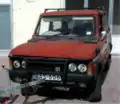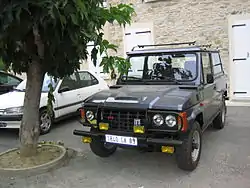ARO 10
ARO 10 was an off-road vehicle produced by ARO and manufactured in Romania. It shares auto-parts with Dacia 1300, from engine to front axle, and was inspired by the Renault Rodeo and Citroën Méhari.[1]
| ARO 10/11 | |
|---|---|
 | |
| Overview | |
| Manufacturer | ARO |
| Also called | ARO Ischia (1984-1985 Italy) ARO SuperIschia (1985-1987 Italy) ARO Enduro x4 (1987-1989 Italy) ARO Dacia (Spain) Dacia 10 Dacia Duster (United Kingdom) ACM Enduro x4 (1987-1989 Italy) |
| Production | 1980–2006 |
| Assembly | Câmpulung-Muscel, Romania |
| Body and chassis | |
| Class | Off-road vehicle |
| Body style | 2-door SUV 2-door convertible 4-door SUV 2-door pickup 4-door pickup |
| Layout | Front-engine, rear-wheel drive / Four-wheel drive |
| Powertrain | |
| Engine | |
| Transmission | 4-speed manual 5-speed manual |
| Dimensions | |
| Wheelbase | 2,400 mm (94 in) - 2,650 mm (104 in) |
| Length | 3,910 mm (154 in) - 4,815 mm (189.6 in) |
| Width | 1,705 mm (67.1 in) |
| Height | 1,790 mm (70 in) |
The ARO 24 Series got a "little brother" in 1980, the ARO 10 Series. While the ARO-24 can be classified as mid-size SUVs, the ARO 10 is about the size of a Jeep Wrangler. It was produced in many body trims, equipped with seven different engines (both gas and Diesel), and came in both 4x2 and 4x4 versions.[2] The ARO 10 was also sold as the Dacia Duster in the United Kingdom and Dacia 10 some international markets.[2] A model derived from the ARO 10, named ARO Spartana, was also produced starting 1997. The last evolution of ARO 10, produced from 1999, was called ARO 10 Super, had a slight design revamp and was built on ARO 24 Series chassis.[3]
First generation
In addition to being sold as the "Dacia Duster" in the United Kingdom and a few other markets, the car received several different names in Italy: Local company Ali Ciemme (ACM) assembled the ARO 10 there in the 1980s and sold it as the "Aro Super Ischia" with the 1.4-liter Renault petrol engine license built by Dacia. When fitted with Volkswagen's 1.6-liter petrol or diesel engines it was sold as the Aro Enduro x4, from 1987 until 1989. A turbodiesel was presented at the end of 1988. Sales volumes of Italian-assembled cars were not very large, reaching 2500 examples in 1987 and 1800 cars in 1988.[4] Volkswagen-engined cars had 28 percent Romanian parts content, with the remainder being Italian and German.[4] The Volkswagen-engined versions also received a stronger differential, to handle the additional torque.[4]
Engines
| Name | Capacity | Type | Power | Torque |
|---|---|---|---|---|
| 1.3 Petrol | 1289 cc | Dacia | 54 hp (40 kW) at 5250 rpm | 89 N⋅m (66 lb⋅ft) at 4000 rpm |
| 1.4 Petrol | 1397 cc | Dacia | 62 PS (46 kW) at 5500 rpm | 100 N⋅m (74 lb⋅ft) at 3300 rpm |
| 1.6 Petrol | 1557 cc | Dacia | 72 PS (53 kW) at 5000 rpm | 122 N⋅m (90 lb⋅ft) at 2500 rpm |
| 1.6 Petrol | 1595 cc | VW | 75 PS (55 kW) at 5000 rpm | 125 N⋅m (92 lb⋅ft) at 2500 rpm |
| 1.6 Petrol | 1598 cc | Daewoo | 105 PS (77 kW) at 5800 rpm | 145 N⋅m (107 lb⋅ft) at 3400 rpm |
| 1.6 Diesel | 1588 cc | VW | 54 PS (40 kW) at 4800 rpm | 100 N⋅m (74 lb⋅ft) at 2300-2900 rpm |
| 1.9 Diesel | 1905 cc | Peugeot | 68 PS (50 kW) at 4600 rpm | 120 N⋅m (89 lb⋅ft) at 2000 rpm |
| 1.9 Diesel | 1870 cc | Renault | 64 PS (47 kW) at 4500 rpm | 121 N⋅m (89 lb⋅ft) at 2250 rpm |
| 1.9 Diesel | 1870cc | Renault | 92 PS (68 kW) at 4250 rpm | 175 N⋅m (129 lb⋅ft) at 2250 rpm |
Spartana
| ARO Spartana | |
|---|---|
 | |
| Overview | |
| Production | 1997–2006 |
| Body and chassis | |
| Body style | 2-door convertible |
| Layout | Front-engine, rear-wheel drive / Four-wheel drive |
| Powertrain | |
| Engine | 1.2 L I4 1.4 L I4 1.6 L I4 1.9 L I4 Diesel |
| Transmission | 5-speed manual |
| Dimensions | |
| Wheelbase | 2,400 mm (94 in) |
| Length | 3,685 mm (145.1 in) |
| Width | 1,645 mm (64.8 in) |
| Height | 1,660 mm (65 in) |
| Curb weight | 950–1,040 kg (2,090–2,290 lb) |
| Name | Capacity | Power | Type | Torque |
|---|---|---|---|---|
| 1.2 Petrol | 1239 cc | Renault | 54 hp (40 kW) at 5300 rpm | 90 N⋅m (66 lb⋅ft) at 2800 rpm |
| 1.4 Petrol | 1397 cc | Dacia | 62 hp (46 kW) at 5500 rpm | 100 N⋅m (74 lb⋅ft) at 3300 rpm |
| 1.6 Petrol | 1557 cc | Dacia | 72 hp (54 kW) at 5000 rpm | 122 N⋅m (90 lb⋅ft) at 2500 rpm |
| 1.6 Petrol | 1598 cc | Daewoo | 105 hp (78 kW) at 5800 rpm | 145 N⋅m (107 lb⋅ft) at 3400 rpm |
| 1.9 Diesel | 1870 cc | Renault | 64 hp (48 kW) at 4500 rpm | 121 N⋅m (89 lb⋅ft) at 2250 rpm |
| 1.9 Diesel | 1870 cc | Renault | 92 hp (69 kW) at 4250 rpm | 175 N⋅m (129 lb⋅ft) at 2250 rpm |
Versions
Sport Utility Vehicles
- ARO 10.1 2-door Convertible
- ARO 10.4 3-door
- ARO 10 Spartana
- ARO 11.4 5-door
Light Commercial Vehicles
- ARO 10.6 Regular Cab Pick-up
- ARO 11.9 Double Cab Pick-up
Other Versions: 10.0, 10.2, 10.3, 10.5, 10.9.[2]
Gallery
 ARO 10 (1980–1991)
ARO 10 (1980–1991) ARO 10 (1992–1999)
ARO 10 (1992–1999) ARO 10 in Lavelanet Canton of Foix arrondissement, Ariège, Midi-Pyrénées, France
ARO 10 in Lavelanet Canton of Foix arrondissement, Ariège, Midi-Pyrénées, France ARO 10 rear view
ARO 10 rear view ARO 10 Super (1999–06)
ARO 10 Super (1999–06)
See also
References
- "ProMotor News - Istoria ARO: gloria şi moartea chinuită a unei legende auto româneşti". 17 September 2018.
- ARO 10 Versions
- Autosoviet: ARO History
- Vecchietti, Filippo (January 1989). "Ali Ciemme: Anche "TD" l'"Enduro x4"" [The Enduro x4 now also turbodiesel]. Quattroruote (in Italian). Vol. 34 no. 399. Milan, Italy: Editoriale Domus. p. 132.